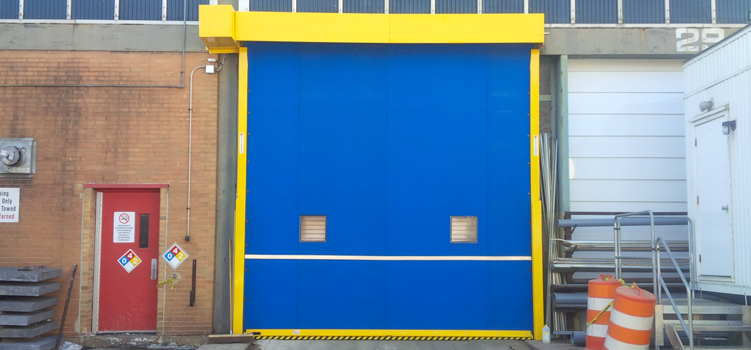Limitation of Sectional Doors
April 22, 2016by performaxGeneral
There are three main uses for an upward acting sectional door, commonly known as an overhead door or garage door. They are residential use, commercial use, and industrial use. Upward acting sectional doors were originally intended for residential use when they were invented in 1921. These doors are often used in commercial environments without high traffic, high usage, and are pretty clean. Common commercial uses are retail warehouses, retail stores, and low use warehousing. Industrial applications tend to be a fast paced manufacturing or warehousing area such as a food manufacturing plant or an automotive plant.
There are three main reasons a sectional door should NEVER be used in an industrial application.
1. The use of exposed torsion springs
Most people do not realize that the weight of a garage door cannot be lifted by the average person. The weight of a door can be anywhere from 150 to 300 pounds. Attempting to lift a door without the use of a spring system is nearly impossible. Adding a garage door opener to a sectional door does not eliminate the use of a torsion spring. Unlike a residential door that uses extension springs, a commercial or industrial door uses torsion springs. Every door manufacturer will warn you not to touch a torsion spring because it is always under tension. Over the years, OSHA and other government agencies have noted serious injuries and fatalities which occurred from people working on torsion springs. Installing a sectional door in an industrial application has sadly contributed to these tragedies.
2. Sectional door hardware is designed for residential or commercial use, not industrial
Every sectional door on the market today uses some of the same hardware as a residential door. An aircraft cable wraps around a drum and is attached to the door sections. When a sectional door is impacted in an industrial application, the cables can come off which causes the door to come down. Even “knockout doors” have this problem. Lastly, sectional doors have exposed tracks into the plant or above the door. The only way to get a sectional door away from the opening is to have a track system that is exposed. Not such a big deal in a commercial application, but it is in an industrial environment. Image a foundry with sectional door tracks sticking out 4 or 5 feet into the building. Once the tracks get hit, the cables can come off causing the door to come down.
3. Sectional doors have limited features
Door technology has not adequately kept up with modern requirements. Today’s industrial applications call for greater than average cycles, speeds, and sizes which did not exist over 90 years ago when the sectional door was invented. The technology really did not change too much until 1992, when the first Knockout Door was invented. European nations appear to be taking this into account. Sectional doors were found only at light duty warehouses and not heavy industrial plants during a recent random sampling in the UK and France.
PerforMax Global is proud to supply industry with safer and energy-efficient alternatives to traditional sectional doors. Click here to learn more
This opinion paper was written by the inventor of the original knock-out door. Through years of industry experience, he has provided his clients with optimal solutions for worker safety and energy cost savings while managing to keep production high. For more information about the author, please visit www.miketich.com


